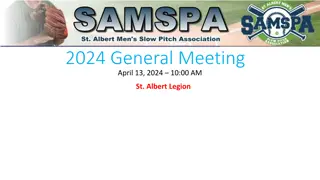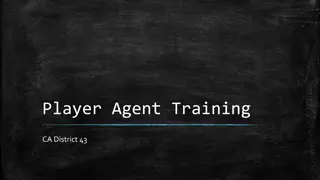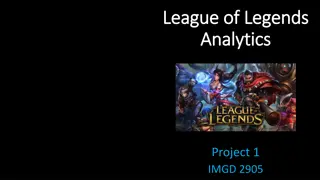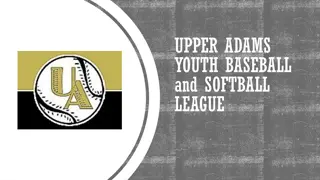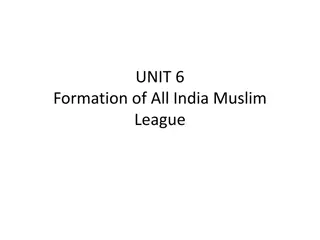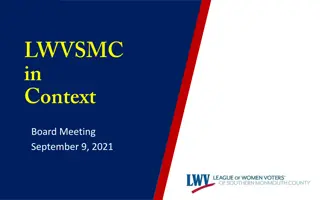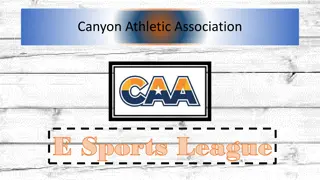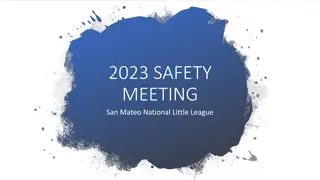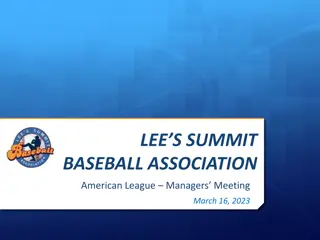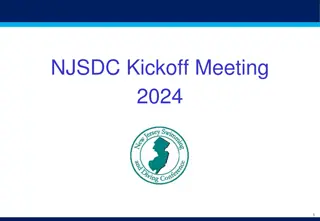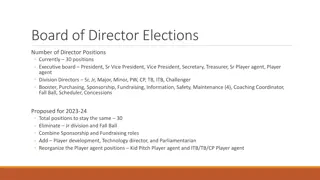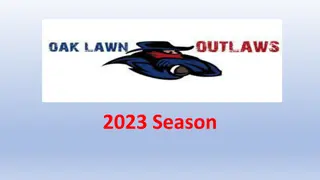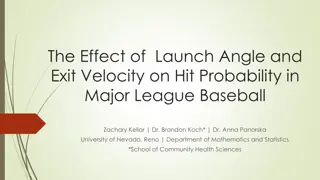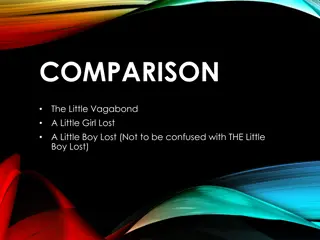Little League Rules and Regulations Guidance
This collection provides essential guidelines for Little League participants, emphasizing respect, safety, and compliance with bat regulations. From knowing and respecting the rules to using the correct bat specifications for different age groups, these images highlight key aspects of maintaining the integrity of the game and fostering a positive environment for players, coaches, and umpires.
Download Presentation

Please find below an Image/Link to download the presentation.
The content on the website is provided AS IS for your information and personal use only. It may not be sold, licensed, or shared on other websites without obtaining consent from the author.If you encounter any issues during the download, it is possible that the publisher has removed the file from their server.
You are allowed to download the files provided on this website for personal or commercial use, subject to the condition that they are used lawfully. All files are the property of their respective owners.
The content on the website is provided AS IS for your information and personal use only. It may not be sold, licensed, or shared on other websites without obtaining consent from the author.
E N D
Presentation Transcript
Know the rules Rules are powerful and knowing them can keep problems to a minimum Respect the umpires They are volunteers and have a hard job to do. Don t make it harder for them.
Love for the game Like working with kids Giving back to the community Self assurance My wife told me to Nobody else would do it
Respect for others Don t scream at the kids Would you talk that way to your mom? No foul language Be proactive If you see a problem coming stop it from happening You are the face of our league
There is no on deck in Majors and below. Only the first batter of the inning shall be out of the dugout before the inning starts. Following batters should not pick up the bat until it is their turn to bat. (On the way to the plate) This is a violation of safety regulations and may be punishable with suspension of the manager and others involved.
Majors and below 2 1/4 in diameter No more than 33 in length 1.15 BPF All of these markings should be clearly legible on the bat. Composite bats are prohibited unless they are noted as approved bats on the Little League approved bat list.
Intermediate and Juniors (11-14) No more than 2 5/8 in diameter No more than 34 in length 1.15 BPF Composite Must be BBCOR certified with -3 weight rating 2 1/4 barrel bats may be used as long as they meet the 1.15 BPF standard (may not be composite)
Seniors 2 5/8 diameter -3 only BBCOR only Wood bats included No more than 36 in length 2 3/4 barrel bats are prohibited Penalty see rule 6.06(d)
1.11 uniform Read from book 1.12 catcher Must wear a catchers mitt 1.13 glove specs 1.15 Pitcher s glove should not be White Gray Distracting Batting gloves under?
1.16 Helmets Worn at all times 1.17 Catcher Must wear a cup Long chest protectors Dangling throat guard on mask No skull caps
2.00 Know them! Knowing these definitions will prevent a lot of problems Questions?
A FAIR BALL is a batted ball that settles on fair ground between home and first base, or between home and third base, or that is on or over fair territory when bounding to the outfield past first or third base, or that touches first, second or third base, or that first falls on fair territory on or beyond first base or third base, or that while on or over fair territory touches the person of an umpire or player, or that, while over fair territory, passes out of the playing field in flight. Where is the ball? FAIR BALL is a batted ball that settles on fair ground between home and first base, or between home and third base, or that is on or over fair territory when bounding to the outfield past first or third base, or that touches first, second or third base, or that first falls on fair territory on or beyond first base or third base, or that while on or over fair territory touches the person of an umpire or player, or that, while over fair territory, passes out of the playing field in flight. Where is the ball?
A FOUL BALL is a batted ball that settles on foul territory between home and first base, or between home and third base, or that bounds past first or third base on or over foul territory, or that first falls on foul territory beyond first base or third base, or that while on or over foul territory, touches the person of an umpire or player, or any object foreign to the natural ground. Hits a player in the box When a batter hits the tee This is a dead ball and all play shall cease. No re FOUL BALL is a batted ball that settles on foul territory between home and first base, or between home and third base, or that bounds past first or third base on or over foul territory, or that first falls on foul territory beyond first base or third base, or that while on or over foul territory, touches the person of an umpire or player, or any object foreign to the natural ground. Hits a player in the box When a batter hits the tee This is a dead ball and all play shall cease. No re- -do do
(a) Offensive interference is an act by a member of the team at bat which interferes with, obstructs, impedes, hinder or confuses any fielder attempting to make a play. If the umpire declares the batter, batter- runner or a runner out for interference, all other runners shall return to the last base that was, in the judgment of the umpire, legally touched at the time of the interference, unless otherwise provided by these rules. Does not have to be intentional Scenarios https://video.search.yahoo.com/video/play;_ylt=A2KIo9RApipWATIAYWH7w8QF;_ylu=X3oDMTEwY3Y3ZTNvBHNlYwNzcgRzbGsDdml kBHZ0aWQDQjEwMDkEZ3BvcwMy?p=baseball+interference&vid=91912e52b1543e232ff4fe3fb42e847c&turl=http%3A%2F%2Ftse3.m m.bing.net%2Fth%3Fid%3DWN.TgyZOrOUMsDINCM0m5Kn8Q%26pid%3D15.1%26h%3D168%26w%3D300%26c%3D7%26rs%3D1&rurl= https%3A%2F%2Fwww.youtube.com%2Fwatch%3Fv%3DmhwFWibkRc0&tit=Rockies+turn+three+thanks+to+interference&c=1&h=168 &w=300&l=106&sigr=11b86i5ns&sigt=119lmcdt4&sigi=12l1lmmkd&age=1400467929&fr2=p%3As%2Cv%3Av&fr=vmn&tt=b
An act by the batter, intentional or not that interferes with a players ability to make a play Scenarios Throw from catcher Runner coming home Batter protected in the box? Ball does not have to be thrown Video Video 2
Running lane 6.05 (j) Coach s interference 5.08 Thrown ball? Rule 3.15 Hit ball? Rookies Player trying to make a play? Rookies Runner s interference section 6.00 Runner out No runners advance unless forced by batter Batter gets 1stbase
OBSTRUCTION is the act of a fielder who, while not in possession of the ball, impedes the progress of any runner. A fake tag is considered obstruction. (NOTE: Obstruction shall be called on a defensive player who blocks off a base, base line or home plate from a base runner while not in possession of the ball.) Does not have to be intentional Scenarios Scenario 2 OBSTRUCTION is the act of a fielder who, while not in possession of the ball, impedes the progress of any runner. A fake tag is considered obstruction. (NOTE: Obstruction shall be called on a defensive player who blocks off a base, base line or home plate from a base runner while not in possession of the ball.) Does not have to be intentional Scenarios Scenario 2
3.09 Read Coaches cannot warm up pitchers 3.15 Who s allowed on the field? 3.17 No electronic devices on the field
Rookies May have defensive coaches on the field Coaches cannot interfere with play Get off the field Interference Out if coach interferes Pitching coaches must stay in contact with rubber Minors and above No defensive coaches on the field (exception in fall) 1stand 3rdbase coaches Must stay in coaches box Cannot interfere with plays or runners Touching or helping a runner in all divisions is interference and the runner will be declared out
Led by umpire-in chief Players legal and properly equipped Ground rules Innings Time limits Modifications The manager is the only one that an umpire wants to talk to If a coach other than the manager attends the pre game meeting then that coach shall be declared manager for that game.
4.03 All players with the exception of the catcher in fair territory Catcher must remain in catchers box Catchers balk With exception of the pitcher and catcher all other players can be anywhere in fair territory
T-ball Unlimited infielders if ground rules state this. Fielders should be placed in traditional positions so that they can gain some concept of the game. Coach pitch 10 infielders with a rover in the outfield. Must have 8 Minors and above Must have a minimum of 9 players (exception in fall)
4.04 Continuous batting order Players may be added to bottom of order if late If a player is removed for illness or injury there is no penalty If a player is ejected from the game then that batting spot should be called out 4.05 base coaches May be coaches or players Must be adult in dugout 4.06 read from book
4.07 EJECTIONS Must leave immediately May not return May not sit in stands Suspended for next game
A 6 inning game (minors and below) has been completed. Time limit has been reached and the inning has been played Mathematical elimination After 4 innings of play a team is ahead so that it is impossible for the other team to catch up in regulation (time should be considered for minors). 4 innings if called for official reasons
Intermediate and up 7 innings have been played and there is a decided winner After 4 innings of play the home team is up by 10 runs. Time has expired and the inning has been played A team concedes the game Note that a game going to Drop Dead time will revert to the previous inning. This is keeping in mind that the home team has not been able to win on runs scored. If it is after the official game time and has not reached the drop dead time and home team pulls ahead, game will be called and a winner declared. 5 innings if called for official reasons
4.15 Gametime A game may be forfeited by the umpire if Read section Include 4.16 4.19 Protests Must be rules based Notify the umpire of the protest No protests in rookies
Rookies When an infielder has control of the ball and all runners have stopped advancing. Minors and above (all other situations) Time shall not be called unless requested by the defense, offense or there is some official reason to call time. Offensive time outs A team shall have ONE offensive time out per inning. Defensive time outs A defensive team can call time to discuss situations but all time outs that are called in which infielders are approached shall be charged to the pitcher. 3 in one inning 4 in a game Explanation Other dead ball situations rule 5.09
(Continuous batting order) In order Batter in box on third out? Bunting with 2 strikes? Swinging and hit by pitch? Double hit?
Three strikes, youre out. Even in T-Ball Coach pitch Three swings or maximum number of pitches Minors and above Strike zone Arm pits to knees Reasonable pitch Questioning balls and strikes Don t do it unless you want to go to your car
Less than 2 out Runners on 1stand 2ndor bases loaded Ball that reaches appreciable height Can be caught with normal Infield Fly Ball is caught Batter is out and runners must tag up. Force is off and runners advance at their own risk Ball is not caught Batter is out. Force is off Runners may run at their own risk Runners do not have to tag up What if a fielder intentionally drops a ball not covered by this rule? 6.05 (k) normal effort by an infielder
Batter out of box? Batter switching boxes? Hit by a strike?
Appeal Batter is out when not batting in proper order Can take place in order before improper batter becomes a runner. Assumes count Appeal must be made before next play Proper batter called out and line up resumes All advancement from improper batter voided If appeal is not made then the order is continued without reference to the incident Scenarios Pg 84
Defensive interference is an act by a fielder which hinders or prevents a batter from hitting a pitch. Delayed dead ball Batter is awarded first base What if ball is hit and put in play?
Home run Ground rule double Under the fence Deflected ball Home run vs. ground rule double 6.09 (h)
Intermediate and above Less than two outs 1stbase not occupied Batter swings at third strike or called third strike Catcher drops ball or ball is not caught in flight Batter can advance to 1stbase with possibility of being put out by either a tag or by the ball being thrown to first base as in any other force play. Two outs Same situation as above with the exception that 1stbase can be occupied. All runners that are forced can be put out. Questions?
7.01 Runner has a right to the base if base is touched before the runner is retired. Fly ball tag up situation/Missed base The runner cannot return to the previous base after the the pitcher has taken his position on the pitchers plate. 7.02 Runners must touch bases in order or in reverse order when needed exception in rule 5.09 when the ball is dead 7.03 one runner per base. Lead runner is entitled to base unless forced
7.04 Batter runner/runners advance Without liability of being put out and if forced When a walk occurs Live ball Missed base? Ball out of play Dead ball 7.05 Throwing equipment or hat etc. at a batted ball Award 3 bases Throwing equipment at thrown ball Award two bases Ball thrown from fielder out of play Award 2 bases This award is based on the position of the runners at the time of the throw Ball from pitcher while on the mound Award 1 base One from the mound, two from the field
Rule 7.05 (i) note 2 One base on an overthrow This is a limit not a reward. The runner is not protected in this situation. Defense still has the opportunity to field the ball and make a play to get an out.
7.07 Batter should be awarded first base when there is interference from the catcher (touching the batter) or another fielder during an attempted steal of home or a squeeze play. This is a balk charged to the catcher and the ball is dead.
7.08 runner is out when Running more than three feet away from his or her baseline to avoid a tag Established when play is being attempted Abandons effort to touch consecutive bases after touching first base Does not slide or attempt to get around a fielder making a play on them Three choices Slide Get around Give up There is no must slide rule Interference with a batted or thrown ball Failure to tag up after a fly ball Appeal play Play can continue without this appeal being made Read 7.08 (f)-(k) 7.09 Interference Covered in definitions
7.09 Appeals Runner is out when Failing to retouch a base after a fly ball is caught Fails to touch a base if returning to a previous base 7.10 (b) Missing a base in advancing Runners may not return to touch a missed base after touching a consecutive base after the ball is dead. However the defensive players can make an appeal that the base was missed May not return to touch a base after a following runner has scored or if they have abandoned the field Scenarios pg 93 Appeal must be made before next pitch or play Example pg 94
7.11 All offensive members should vacate any space that is needed for a defensive player to make a play 7.12 I two are out before an appeal. All runners following the runner that the appeal was made on are affected by the appeal. However preceding runners are not affected unless the third out is made before runs score or if the appeal would have originally been a force play. A runner tagging up after a fly ball is not a force. Example
7.13 Rookies May not leave the base until ball is put in play Time called when runners stop advancing and an infielder has control of the ball Minors and below Runners may not advance until the ball reaches the batter Runners leaving early affect all other runners Placement of runners based on batted ball (judgment) Poof play
8.01 Two legal positions The windup Facing the batter One foot in contact with the plate and the other foot free Can do three things Deliver the pitch Step and throw to a base Distance and direction Disengage Pivot foot Cannot go to stretch or set position Cannot lift leg except in delivery of the pitch
The set position (stretch) Pivot foot in contact with plate Free foot in front Must come to a complete stop before delivering the pitch to the batter (complete and discernible stop) Does not apply in minors and below Can make any movements until they come set except to disengage incorrectly Can step and throw to a base Distance and direction Before the throw Step off back of plate to disengage
Illegal pitch (dead vs. delayed dead) pg 101 No runners on all divisions Not in contact with pitcher s plate Counted as a ball in the count Exception It is ball four The batter puts the ball in play and reaches first base Hit batter Tee Ball Pitcher must remain in contact with the plate until ball is hit











 undefined
undefined




